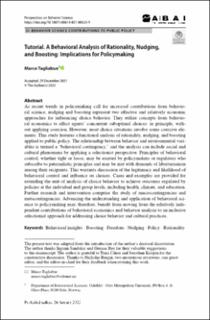| dc.contributor.author | Tagliabue, Marco | |
| dc.date.accessioned | 2022-01-28T09:20:34Z | |
| dc.date.available | 2022-01-28T09:20:34Z | |
| dc.date.created | 2022-01-27T11:34:58Z | |
| dc.date.issued | 2022-01-26 | |
| dc.identifier.citation | Perspectives on Behavior Science. 2022, . | en_US |
| dc.identifier.issn | 2520-8969 | |
| dc.identifier.issn | 2520-8977 | |
| dc.identifier.uri | https://hdl.handle.net/11250/2930408 | |
| dc.description.abstract | As recent trends in policymaking call for increased contributions from behavioral science, nudging and boosting represent two effective and relatively economic approaches for influencing choice behavior. They utilize concepts from behavioral economics to affect agents’ concurrent suboptimal choices: in principle, without applying coercion. However, most choice situations involve some coercive elements. This study features a functional analysis of rationality, nudging, and boosting applied to public policy. The relationship between behavior and environmental variables is termed a “behavioral contingency,” and the analysis can include social and cultural phenomena by applying a selectionist perspective. Principles of behavioral control, whether tight or loose, may be exerted by policymakers or regulators who subscribe to paternalistic principles and may be met with demands of libertarianism among their recipients. This warrants discussion of the legitimacy and likelihood of behavioral control and influence on choices. Cases and examples are provided for extending the unit of analysis of choice behavior to achieve outcomes regulated by policies at the individual and group levels, including health, climate, and education. Further research and intervention comprise the study of macrocontingencies and metacontingencies. Advancing the understanding and application of behavioral science to policymaking may, therefore, benefit from moving from the relatively independent contributions of behavioral economics and behavior analysis to an inclusive selectionist approach for addressing choice behavior and cultural practices. | en_US |
| dc.description.sponsorship | Open access funding provided by OsloMet - Oslo Metropolitan University. | en_US |
| dc.language.iso | eng | en_US |
| dc.publisher | Springer | en_US |
| dc.relation.ispartofseries | Perspectives on Behavior Science; | |
| dc.rights | Navngivelse 4.0 Internasjonal | * |
| dc.rights.uri | http://creativecommons.org/licenses/by/4.0/deed.no | * |
| dc.subject | Behavioral insights | en_US |
| dc.subject | Boosting | en_US |
| dc.subject | Freedom | en_US |
| dc.subject | Nudging | en_US |
| dc.subject | Policies | en_US |
| dc.subject | Rationality | en_US |
| dc.title | Tutorial. A Behavioral Analysis of Rationality, Nudging, and Boosting: Implications for Policymaking | en_US |
| dc.type | Peer reviewed | en_US |
| dc.type | Journal article | en_US |
| dc.description.version | publishedVersion | en_US |
| dc.rights.holder | © 2022 The Author(s) | en_US |
| cristin.ispublished | true | |
| cristin.fulltext | original | |
| cristin.fulltext | postprint | |
| cristin.qualitycode | 2 | |
| dc.identifier.doi | https://doi.org/10.1007/s40614-021-00324-9 | |
| dc.identifier.cristin | 1991179 | |
| dc.source.journal | Perspectives on Behavior Science | en_US |
| dc.source.pagenumber | 30 | en_US |

